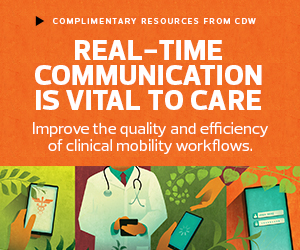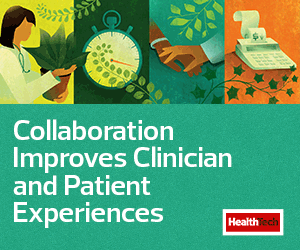What Are Clinical Communication and Collaboration Tools?
“Mobility is more important than ever in clinical settings. Hospital systems are actively looking to replace single-purpose devices such as pagers with modern communication methods like secure messaging that provides patient context,” say Mike Goad, senior healthcare mobility solution architect at CDW•G, and Remy Morgan, senior inside solution architect with CDW’s mobility practice, in a CDW blog. “Workers in healthcare rely on smartphones and tablets to exchange information and complete work tasks on the go — an especially important consideration for workers who operate throughout an entire floor, building or even campus.”
Functionalities such as role-based calling, dynamic directory and active response make clinician workflows more efficient. Role-based calling allows a clinician to look at a patient’s information in the CC&C platform to find the associated care team, which can be searched via roles. Dynamic directory provides an escalation path to ensure that a clinician’s message receives a response, while active response enables the creation of rapid response groups. The platform can send an alert directly to members of the group, eliminating the need for noisy overhead paging.
Many CC&C platforms include additional capabilities, such as integrated electronic health records and barcode medication administration.
LEARN MORE: Find out 3 tips to integrate EHRs with CC&C tools.
How CC&C Tools Are Transforming Healthcare Workflows
“Before, it took a lot of time to reach providers and sometimes respiratory therapists because we just used the paging system,” says Kassaundra McKnight-Young, lead clinical informaticist at University Health (formerly Truman Medical Centers). “They would have to stop, find a phone and call back. Then, if you’re not there, that’s usually it. ‘Who paged red team? Who paged the respiratory therapist?’ I have to take care of my patients, so I’ve left. They don't know who paged who, when they paged them or why they paged them. So, we have to start that process all over again. Real-time communication, instant communication, improved response time and improved call-in time is what has been beneficial.”
University Health paired Zebra Technologies’ TC51-HC mobile computers with Cerner’s Camera Capture, enabling clinicians to securely text high-quality medical images. The hospital system also uses Cerner Patient Observer, enabling immediate communication between the patient and the correct caregiver, depending upon the patient’s needs.
“If they just need water, a care tech can get that for them and it will route to the care tech that’s taking care of them, versus if they need pain medication, it can route to the nurse that’s taking care of them,” says McKnight-Young.
Click the banner below to learn how a clinical mobility workshop can improve care.













